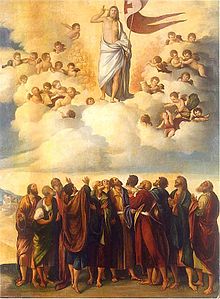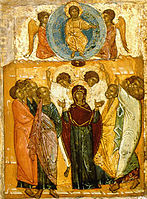Ascension of Jesus in Christian art

The Ascension of Jesus to Heaven as stated in the New Testament has been a frequent subject in Christian art, as well as a theme in theological writings.[2]
The earliest direct depictions of the Ascension date to around the beginnings of the 5th century, often based on the Hand of God representations and by the 6th century the iconography had been established.[3][4]
In many depictions, (and always in the
Development of the iconography
New Testament scenes that appear in the
An ivory plaque in Munich with such a scene is usually dated around 400, and is possibly the earliest Ascension image.[8] This was to remain the most common type in the West for several centuries, and for example is repeated in the Drogo Sacramentary some 450 years later (see gallery). The crucifixion scene is virtually unknown in the 5th century and rare until the 6th century. By the 6th century, however, more images of both the Crucifixion and the Ascension began to appear, perhaps as a result of the theological discussions of the late 4th and early 5th centuries.[3]
The
By the 6th century the iconography of the Ascension had been established and by the 9th century Ascension scenes were being depicted on domes of churches.
The Ascension of Jesus is not the only depiction of ascension and other figures, such as John the Evangelist, have been separately depicted as ascending to Heaven, following a medieval story in the Golden Legend.[1] The name of the Assumption of Mary indicates that this was a passive transit; depictions in art often show her being carried up on a cloud by angels.
Composition and meaning

Ascension scenes fall naturally into two zones, an upper heavenly part and a lower earthly part. The ascending Christ may be carrying a resurrection banner or make a sign of benediction with his right hand.[1] The blessing gesture by Christ with his right hand is directed towards the earthly group below him and signifies that he is blessing the entire Church.[6] In the left hand he may be holding a Gospel or a scroll, signifying teaching and preaching.[6] From the Renaissance on the angels may not be present.
The earthly part of the Ascension depictions do not only represent those believed to have been present at the Ascension, but the entire Church.
The
Other scenes with a similar raised figure, that used similar compositions to the Ascension are the
Gallery
Western church
Paintings and mosaic
-
Giotto, 14th century
-
Andrea Mantegna, 1461
-
Pietro Perugino, San Pietro Polyptych, 1496–1500
-
16th century, German "disappearing feet"
-
Garofalo, 1510–1520
-
Rembrandt, 1636
-
Benjamin West 1801
-
Rosary Basilica, Lourdes, 19th century
Illuminated manuscripts
-
Drogo Sacramentary, c. 850
-
Bamberg Apocalypse, 11th century
-
Très Riches Heures du Duc de Berry, c. 1410
-
Workshop of Ghirlandaio, 15th century
Relief depictions
-
Anglo-Saxon(?) ivory relief, 8th century
-
UnusualEvangelists' symbols
-
A rather late version of the "disappearing feet" depiction in wood relief, 1597
-
Christ ascending alone, Aulendorf, Germany, 1711
Eastern church
Icons and mosaic
-
Biggest mosaic of Ascension of Jesus in Christian world which weighs 40 tons in central dome of Saint Sava Cathedral in Belgrade
-
14th century Novgorod School
-
Andrei Rublev, 1408
-
St. Cyril-Belozersky Monastery, 1497
-
19th century Macedonian icon, Bitola, Macedonia
See also
- Art in Roman Catholicism
- Christian art
- Resurrection of Jesus in Christian art
- The Reformation and art
- Transfiguration of Jesus in Christian art
References
- ^ ISBN 0-313-24658-0 pp. 26–27 [1]
- ISBN 1-60136-000-2 entry under Ascension.[2]
- ^ ISBN 978-0-664-22416-5pp. 51–53
- ^ ISBN 0-264-67487-1pp. 137–138
- ^ ISBN 0-8028-2916-3p. 87
- ^ ISBN 0-913836-77-Xp. 197
- ^ ISBN 978-0-313-29329-0pp. 25–26
- ^
- ISBN 0-88141-098-5p. 61
- ^ Christian Iconography: a Study of its Origins by André Grabar 1968 Taylor & Francis Publishers, p. 76
- ISBN 978-0-495-57360-9pp. 244–245
- ^ The Spirituality of the Rites of the Holy Liturgy in the Coptic Orthodox Church by Bishop Mettaous 2000, Orthodox Church Press, pp. 133–134
- ^ Elly Cassee, Kees Berserik and Michael Hoyle, The Iconography of the Resurrection: A Re-Examination of the Risen Christ Hovering above the Tomb, 1984, The Burlington Magazine, Vol. 126, No. 970 (Jan., 1984), pp. 20–24 JSTOR





















